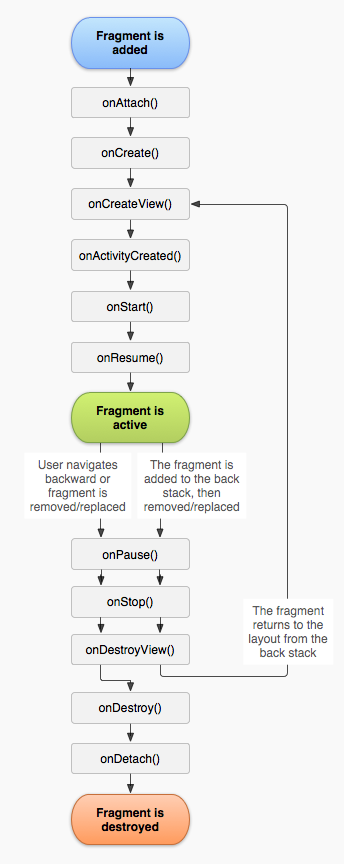Fragment的生命周期
因为Fragment必须嵌入在Acitivity中使用,所以Fragment的生命周期和它所在的Activity是密切相关的。
如果Activity是暂停状态,其中所有的Fragment都是暂停状态;如果Activity是stopped状态,这个Activity中所有的Fragment都不能被启动;如果Activity被销毁,那么它其中的所有Fragment都会被销毁。
但是,当Activity在活动状态,可以独立控制Fragment的状态,比如加上或者移除Fragment。
当这样进行fragment transaction(转换)的时候,可以把fragment放入Activity的back stack中,这样用户就可以进行返回操作。
使用Fragment时,需要继承Fragment或者Fragment的子类(DialogFragment, ListFragment, PreferenceFragment, WebViewFragment),所以Fragment的代码看起来和Activity的类似。
<sdk>/extras/android/support/v4/android-support-v4.jar.
它就提供了Fragment的APIs,使得在Android 1.6 (API level 4)以上的系统都可以使用Fragment。当创建包含Fragment的Activity时,如果用的是Support Library,那么继承的就应该是FragmentActivity而不是Activity。
必须实现的三个函数
onCreate()系统在创建Fragment的时候调用这个方法,这里应该初始化相关的组件,一些即便是被暂停或者被停止时依然需要保留的东西。
onCreateView()
当第一次绘制Fragment的UI时系统调用这个方法,必须返回一个View,如果Fragment不提供UI也可以返回null。
注意,如果继承自ListFragment,onCreateView()默认的实现会返回一个ListView,所以不用自己实现。
onPause()
当用户离开Fragment时第一个调用这个方法,需要提交一些变化,因为用户很可能不再返回来。
把Fragment加入Activity
当Fragment被加入Activity中时,它会处在对应的View Group中。Fragment有两种加载方式:一种是在Activity的layout中使用标签<fragment>声明;另一种方法是在代码中把它加入到一个指定的ViewGroup中。
另外,Fragment它可以并不是Activity布局中的任何一部分,它可以是一个不可见的部分。这部分内容先略过。
加载方式1:通过Activity的布局文件将Fragment加入Activity
在Activity的布局文件中,将Fragment作为一个子标签加入即可。<?xml version="1.0" encoding="utf-8"?>
<LinearLayout xmlns:android="http://schemas.android.com/apk/res/android"
android:orientation="horizontal"
android:layout_width="match_parent"
android:layout_height="match_parent">
<fragment android:name="com.example.news.ArticleListFragment"
android:id="@+id/list"
android:layout_weight="1"
android:layout_width="0dp"
android:layout_height="match_parent" />
<fragment android:name="com.example.news.ArticleReaderFragment"
android:id="@+id/viewer"
android:layout_weight="2"
android:layout_width="0dp"
android:layout_height="match_parent" />
</LinearLayout>当系统创建这个Activity的布局文件时,系统会实例化每一个fragment,并且调用它们的onCreateView()方法,来获得相应fragment的布局,并将返回值插入fragment标签所在的地方。
有三种方法为Fragment提供ID:
android:id属性:唯一的id
android:tag属性:唯一的字符串
如果上面两个都没提供,系统使用容器view的ID。
加载方式2:通过编程的方式将Fragment加入到一个ViewGroup中
当Activity处于Running状态下的时候,可以在Activity的布局中动态地加入Fragment,只需要指定加入这个Fragment的父View Group即可。首先,需要一个FragmentTransaction实例:
FragmentManager fragmentManager = getFragmentManager()
FragmentTransaction fragmentTransaction = fragmentManager.beginTransaction();之后,用add()方法加上Fragment的对象:
ExampleFragment fragment = new ExampleFragment();
fragmentTransaction.add(R.id.fragment_container, fragment);
fragmentTransaction.commit();最后需要调用commit()方法使得FragmentTransaction实例的改变生效。
参考:
Android Fragment 基本介绍
http://www.cnblogs.com/mengdd/archive/2013/01/08/2851368.html























 1万+
1万+

 被折叠的 条评论
为什么被折叠?
被折叠的 条评论
为什么被折叠?








